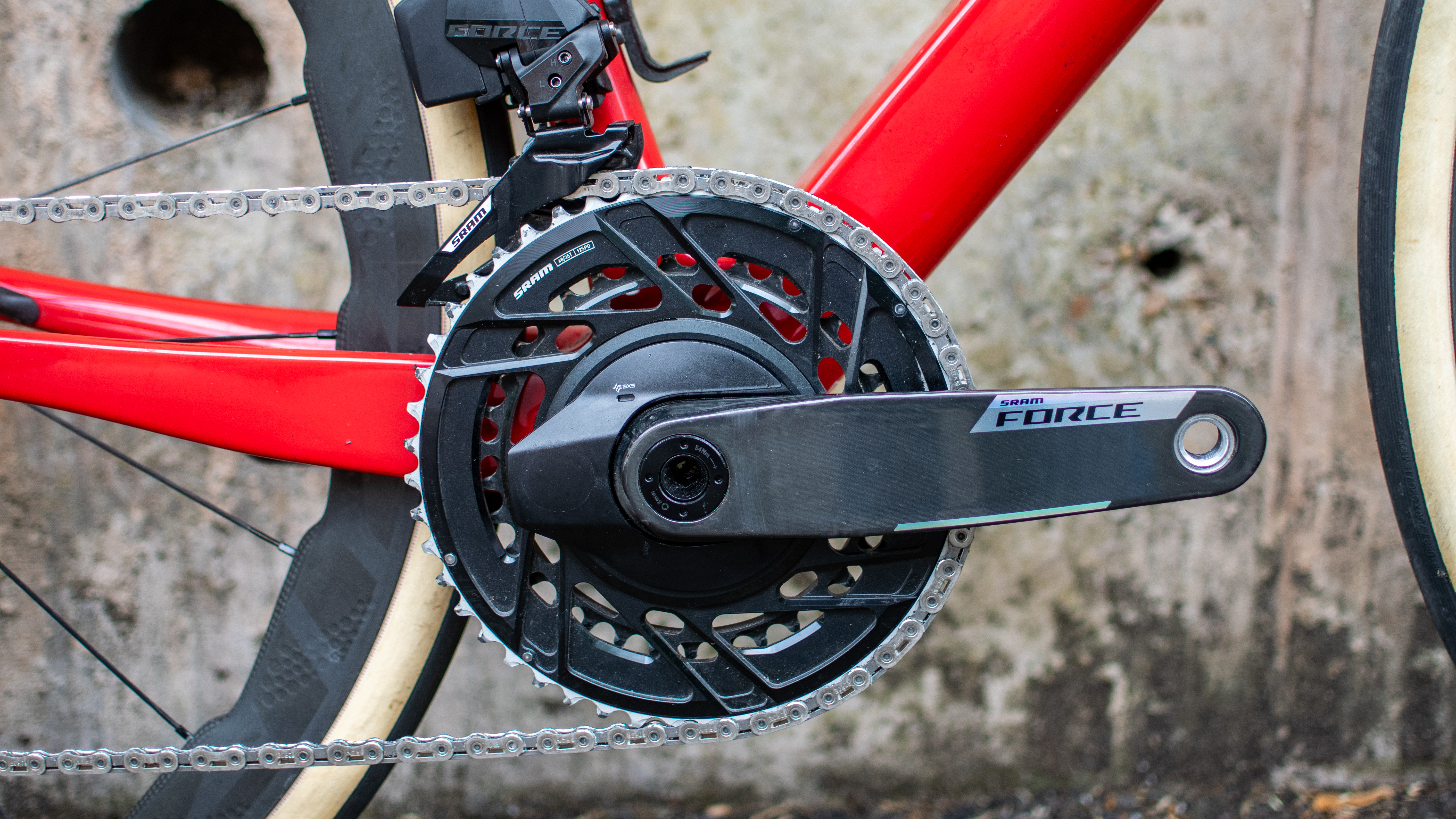Cyclingnews Verdict
SRAM Force AXS is an excellent groupset, and SRAM has done a very good job of uprating it with some of the best tech from Red that makes the performance difference between the two smaller than ever. This is a great new chapter for Force.
Pros
- +
Excellent new shifter ergonomics and bonus buttons
- +
Huge braking performance upgrade
- +
Improved front shift performance
- +
XPLR gravel 1x option
Cons
- -
Wider, flatter crank shape not as aesthetically pleasing for me
- -
The top pulley wheel is hard to clean in place
You can trust Cyclingnews
Price: $2,842 / £2,582 with power meter chainset.
Total weight: 2959 grams
Power Meter: Yes, spider mounted
Drivetrain options: 1x or 2X - 12 speed / 1x13 XPLR variant
SRAM recently launched a brand new, updated version of its wireless, electronic Force AXS groupset. There were also technically three other groupsets included in the release: an XPLR Force gravel variant and the same for the one-tier-lower Rival groupset.
I attended the launch of the SRAM Red AXS groupset last year and have done a lot of riding with it since, including a mega day out at the Marmotte Granfondo. I'll hold back from calling it a game changer, but there are elements of that groupset that SRAM has nailed. Specifically, the braking improvements, shifter ergonomics and front shifting; it's comfortably one of the best road bike groupsets on the market.
At the time, I was excited at the thought of some of that sweet Red tech being cascaded down the SRAM groupset tiers so that other, more affordable groupsets could benefit as well.
Fast forward just over a year, and that is what’s happened. The latest version of Force has a new lever shape that’s pretty much the same as Red AXS, the shifters also have a pair of bonus shift buttons - the same as Red - and a fantastic new light braking action. There's very good stopping performance, as well as improvements in the shifting department, plus the weight, as usual, has been trimmed.
There is a pretty wide range of potential spec configurations depending on what you go for, but a 2X groupset with a power meter retails at $2,842 / £2,582, and that price also includes a Hammerhead Karoo computer, which integrates with the Red AXS system. Whether you want a new bike computer is perhaps another matter, but there is no option to buy it without.

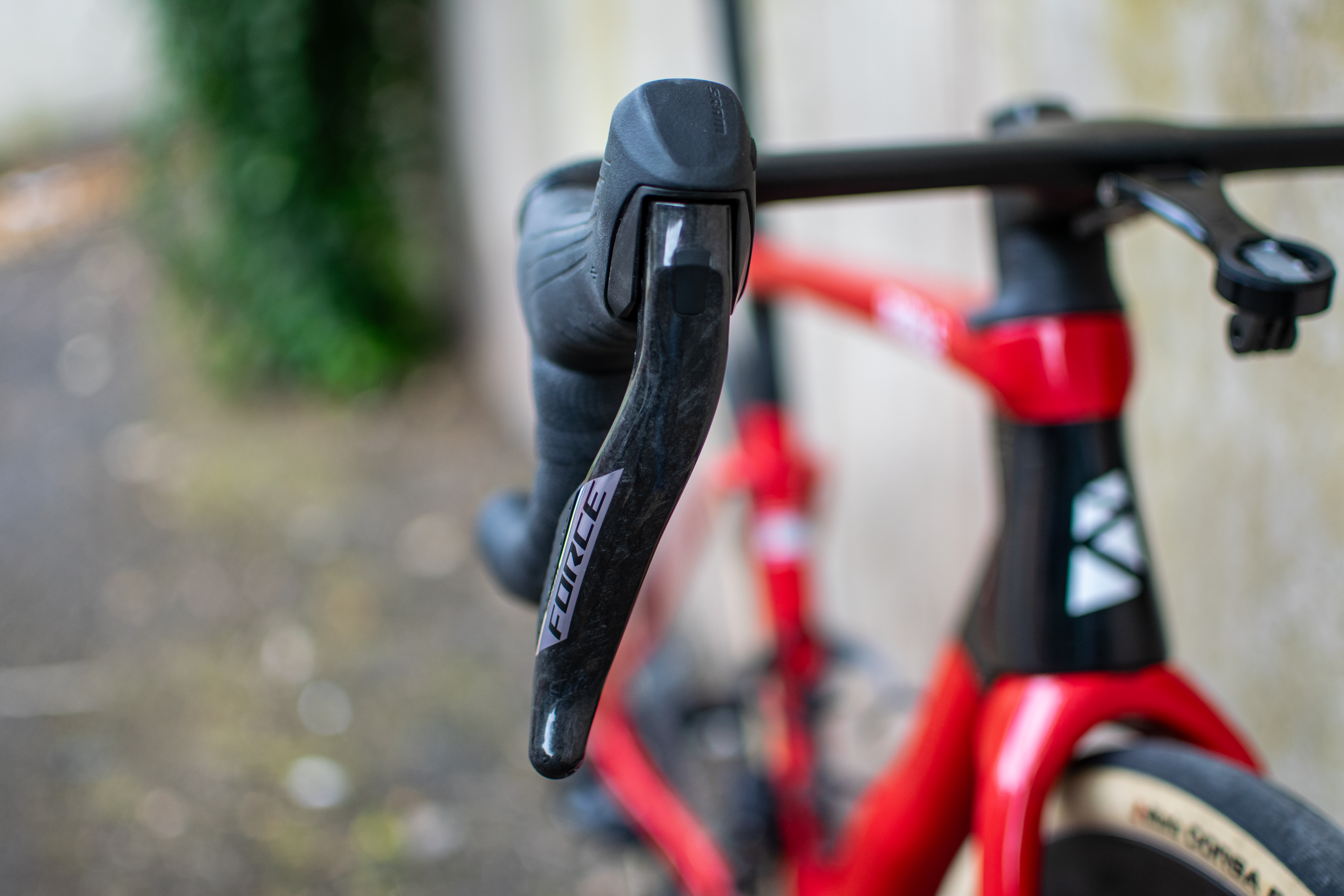
Design and Aesthetics
Visually, Force retains a lot of the aesthetics the outgoing generation had. The mostly black component colour is still there, and there are the Silvery metallic Force logos.
The most obvious changes have taken place at the shifters, with their new updated shapes, the chainset, which has different-shaped crank arms, and the rear mech, which gets a cutout in the body to drop a few grams.
The latest race content, interviews, features, reviews and expert buying guides, direct to your inbox!
Lastly, if you are looking at the brake callipers, they are still black, but have some lightened sections where material has been removed from the caliper body, though they are claimed to be stiffer now.
It all looks smart to me; modern and up to date. The carbon fibre brake levers especially look trick. The only components I'm not totally on board with aesthetically are the wider, flatter crank arms, which don't look quite as elegant.
Weight-wise, the groupset in a double configuration is around 183 grams lighter than the previous group, as quoted by SRAM. Dropping some weight is always nice, but for where groupsets are at now, unless something drastic happens, we shouldn't expect huge weight reductions.
Red AXS is very light, the weight reduction is where a lot of the extra spend goes, and in a double configuration, it is about 463 odd grams lighter than Force, which is a good chunk. Those weights are based on SRAM's claimed groupset weights; I haven't weighed it all myself.

The Force levers now share the same shape as Red and feature the same bonus shifter buttons, carbon lever blades, internal brake piston relocation and easy-to-access reach adjusters on the front of the levers, which are very easy to use. It's a big levelling up for Force overall.
SRAM also told me the Force and Red shifter hoods are interchangeable, so if you think you might prefer the more textured Force bonus buttons, as I do. You could install Force hoods onto your Red shifters. It also just means more spares are available generally if you wear your hoods out.
On the subject of interchangeability, the new Force levers and calipers are backwards compatible, which is nice. The new levers and braking performance would make a mighty upgrade to the previous gen groupset, and let's face it, plenty of us chip away at upgrades over time to spread the cost.
The Force dual-sided Quarq power meter offers +/-1.5% accuracy, again, the same as Red. The standard crankset can also be upgraded with a left-hand-sided Force power meter crank arm option. There is also now a threadmount integrated chainring option, which means chainring and power meters can be separated.


The Force front mech has also been narrowed and tweaked to improve front shifting. The previous gen Force front mech shifting performance had frustrated me in the past; performance from Force AXS has been excellent, and I have deliberately tried to upset it.
The inboard front mech cages are the same on Red, Force and Rival, whilst the outboard side of the cage is stamped steel on Force and Rival, and aluminium on Red to shed weight.
SRAM told me that the stiffness differences would be imperceptible here and that the inner plate provides the small-to-big ring shifting surface, so if the setup is correct, performance should be the same. On the subject of differences - or lack of - the drivetrain rivets, ramps, and teeth are also the same across Red, Force and Rival, another point to show how technology is shared.
One difference in the rear derailleurs is the spring clutch in the Force rear mech arm, versus the more complex (and expensive) orbital damper in the Red rear mech.
The Force and Red AXS brakes are as powerful as each other. Force doesn't have the weight-saving caliper cutouts that Red has, but they should have the same stopping power, more on this below.
The Force chain is pretty similar to Red, one of the key differences is that it loses the hollow chain-link pins that Red has, but the flat top profile with plate cutouts is the same, as is the hard chrome finish. The chain is also compatible with the 13 cog XPLR gravel cassette, so you don't need to worry about compatibility there. SRAM is also offering a purple version of the Force chain, just as a fun alternate option.
A wide range of gearing options are available, though the front double chainset only goes up to a 50T chainring officially, which may frustrate some. There are 50/37T, 48/35T and 46/33T chainsets available, and larger 1x chainrings, as well as 10-28 / 10-30 / 10-33 / 10-36T cassettes. I rode with 35/48 - 10-33T gearing.
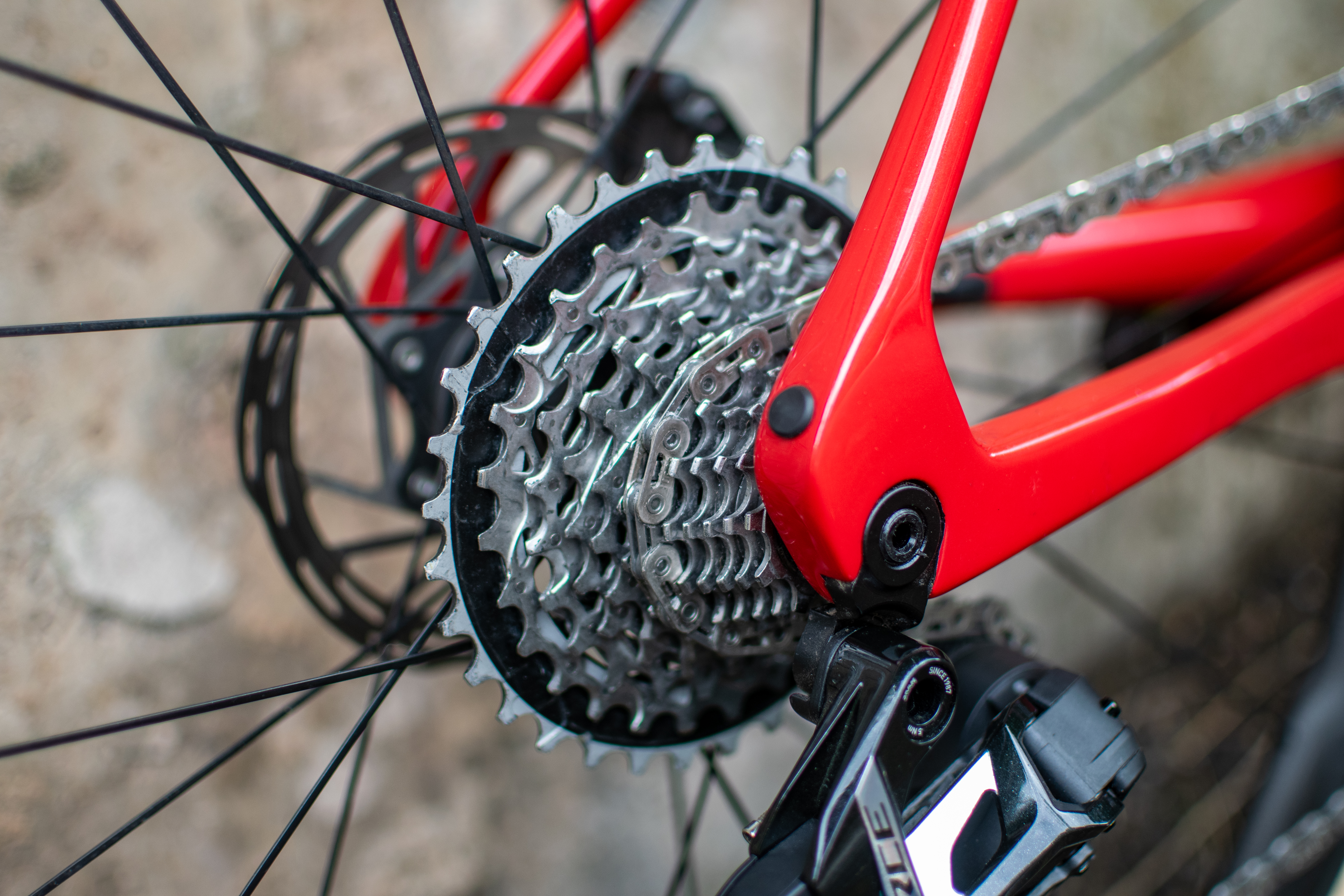
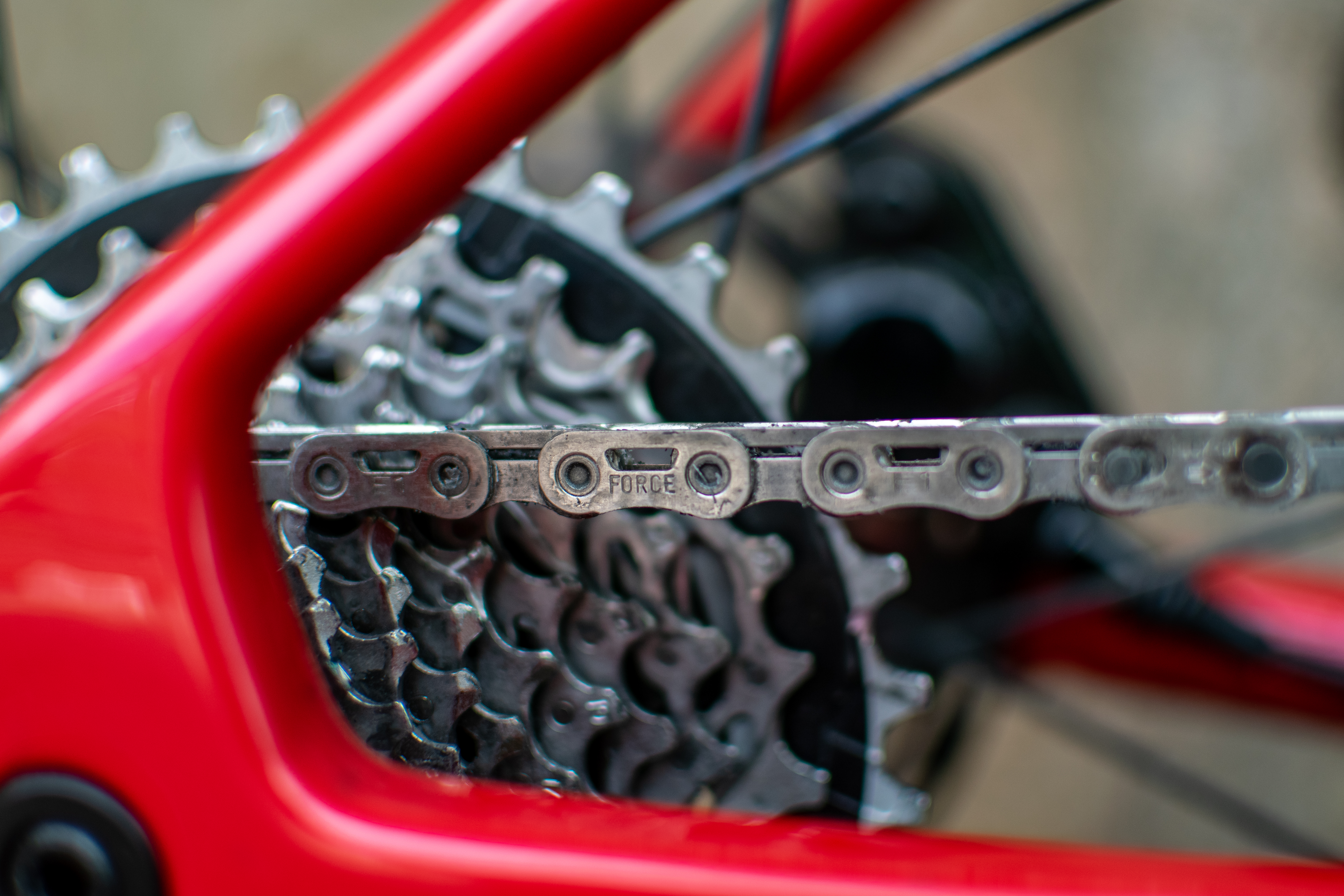
Performance
Force AXS has performed near faultlessly for me across a range of different riding, and it's certainly been a successful test. This is another very good groupset from SRAM.
Feel and feedback play a big part in the opinions we form on braking and shifting performance - a big part of how a groupset performs, and generally, it's easy to tell when things aren't right.
First, for some context, SRAM supplied the groupset fitted to a new Ribble Ultra Race road bike for me to test. That same bike came with the 353 NSW wheels with tyre pressure sensors, which I am also testing in tandem.
Pairing the groupset in the SRAM AXS app was very simple. Everything showed up straight away (you can shake the bike to pair components), and pairing and syncing are very easy to do. Then you can configure things like bonus buttons, update the firmware of components and check battery life; this is the case for all AXS groups.
Shifting has generally been very good. The front has been impressive, with zero dropped chains or snags anywhere, and I've deliberately shifted poorly at times to try and drop the chain at the front. The new, narrower Force mech handled the abuse with finesse.

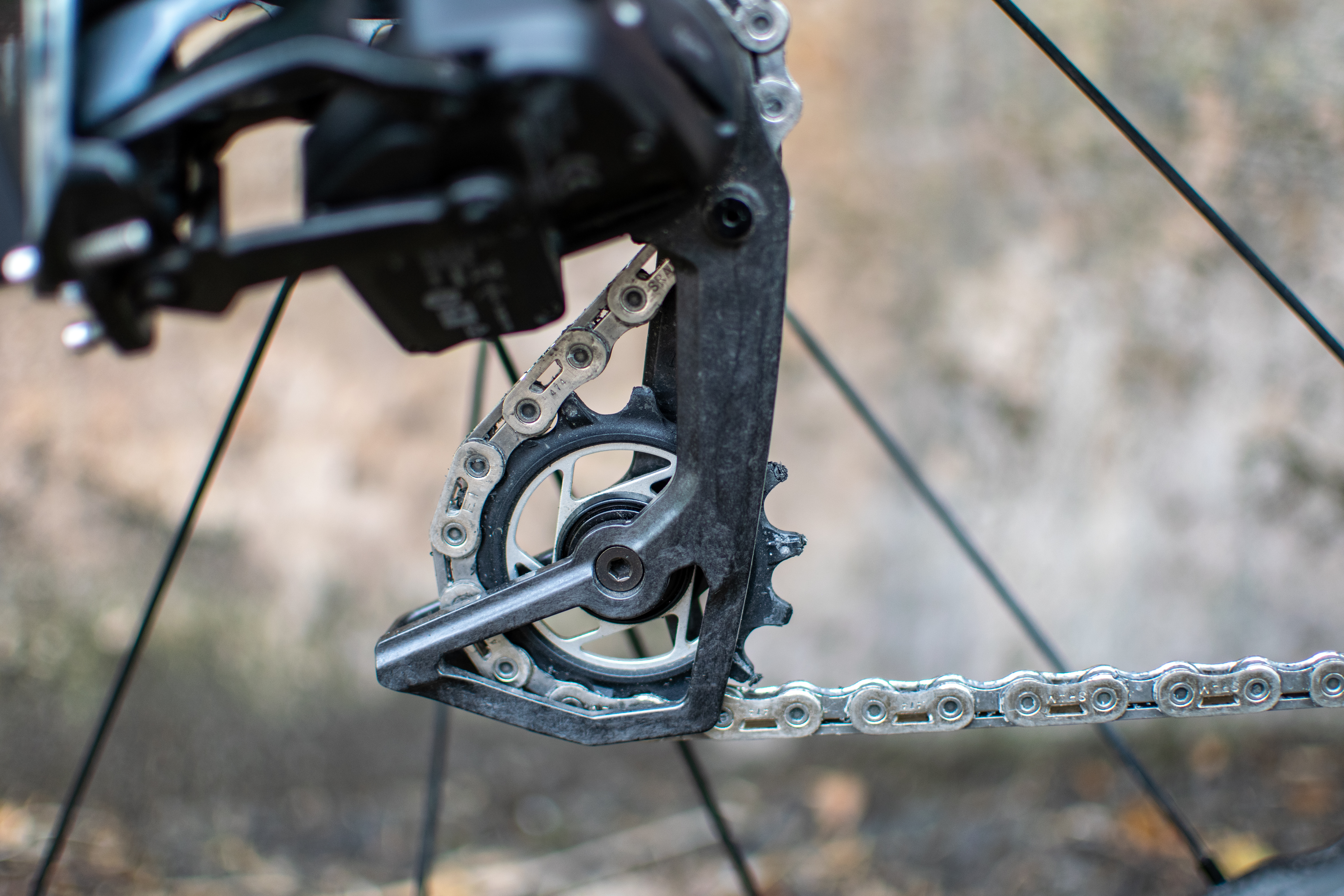
Shift speed itself is good, and I can't really complain about any of it. Force and Rival AXS groupsets also share the same wireless protocol as Red, which was shortened to speed up shifts, so there has been an improvement across the board here.
I will remake the point I made in my Red review that a proper and correct front derailleur setup will dictate front shifting performance. The groupset ships with a setup tool, but if you're struggling to achieve perfect shifting, read the manufacturer's manual and or find someone who can nail it for you; it may just make all the difference. That point stands for any 2x groupset as well, not just SRAM ones.
Shifting at the rear has also been very good, though perhaps not quite as smooth and silent as Red. The Red cassette makes things a little quieter at the back when shifting. I have had some rasping when in the big chainrings and the largest rear sprocket at times, as well as the odd clunky shift at the rear. I did check my test bike's hanger alignment with my Abbey Tools HAG alignment tool and made a small tweak, so this could have contributed to any misshifts.
Certain shifts at the rear have been absolutely perfect, though, and I do mean perfect. I also felt this with Red last year. Shifting overall is very good, comfortably in line with what you should expect from a good electronic groupset, but at certain speeds and cadences, you change gears, and it's a seamless joy.
Derailleur hanger alignment and proper setup also dictate shift performance, especially now electronic groupsets are dominant and mechanical gear cable condition and setup are no longer as much of a factor, so always check these things.

The new Force braking action and performance have been near perfect, and I have put the brakes to the test. I have descended one of, if not the steepest, A roads in Britain, Porlock Hill on a damp morning, as well as several mountains at the Marmotte Granfondo recently, including the Col du Galibier and Alpe d'Huez.
The brakes are excellent. They always slow you down with power and control, and the effortless braking action is lovely. I was braking hard on mountain descents all day at the Marmotte in 30+ degree heat, and aside from some squealing at times due to heat, the brakes were a real asset and saved me effort and energy.
I'm testing a gravel bike currently with Red AXS levers and calipers, and the feel at the lever is very similar; I can't detect much of a difference at all; both are crisp, positive and super smooth.
I noticed the difference between the two bikes, 140 and 160mm disc rotor size, on my first ride, but both sizes of rotors are available for Force, too. If you want a bit more power, then size up to 160mm discs. I'm not the biggest rider, so the 140s work perfectly for me.
I wanted to know if any differences exist between Force and Red that mean Red brakes are more powerful, and SRAM told me there is nothing that would make Force brakes any less powerful, so it seems to be mainly a weight thing. If you assume your equipment is all in good condition, the brake pads are bedded in properly, and the brakes are bled well, there's no reason Force won't be as powerful as Red, which is pretty cool.
Value
Force is a very good groupset, and the performance on offer is excellent; it's now very close to that of the flagship Red groupset.
Why spend more on Red? It looks more bling, and you're going to save a good chunk of weight - the thick end of half a kilogram. This will matter to pros like Jonas Vingegaard, who are trying to win the Tour, but for regular riders it's no deal breaker. Ok, if you're going for a really light overall bike build, Red will bring the weight down, but it's not essential and costs a good chunk more.
A name that's going to come up when discussing Force is Ultegra. On paper, the second-tier groupset from Shimano is Force's direct competitor and is a little lighter. The current version of Ultegra has been on the market for several years and can be found for a cheaper price than SRAM Force AXS right now, as can Dura-Ace if you shop around. Ultegra also provides excellent performance. So, from a purely cost-saving point of view, it provides a cheaper option.
With Force, though, you are getting, depending on what you buy, a very dependable dual-sided power meter and an excellent bike computer in the Hammerhead Karoo that integrates very well with the SRAM system, if you need one. Shimano power units by comparison, are generally regarded a being a little inconsistent. I do think these points boost value, as does the wireless technology that aids modern, integrated bike builds.
I can see how an included computer, if you buy a whole groupset, might be frustrating. Especially if you really love your own model. I think my outlook has softened on this due to the Hammerhead Karoo being a genuinely excellent computer, my own favourite, I use it when I'm not testing something else. At the very least, I'd say give it a fair run out for a time if you do invest, the maps in particular are fantastic, and you could also move it on if it's not for you.
It's more money than the competition right now as a standalone groupset, but it all works excellently and feels very fresh, up-to-date and very user-friendly. That's to say nothing of the range of bikes it will be specced on as standard. I think Force offers good value for money.
Verdict
As it did with Red, SRAM has made an excellent update to Force, and it narrows the performance difference between the two groupsets.
The groupset has performed fantastically, and the bonus shift buttons and braking performance in particular are very good features that add value and really boost the user experience. SRAM also seems to have shared a great deal of tech with Force and Rival to raise the bar overall.
In fact, SRAM are out in front at the moment regarding road groupsets if you ask me, though there are signs that new Shimano road groupsets may be on the way in the future. We have no idea when yet, but the new wireless battery tech on XTR and GRX perhaps hints at some movements behind the scenes.
Force is an excellent new addition to the SRAM road lineup. I'll happily ride with it anytime.
Value | At full rrp it is expensive, and you can find Ultegra (the direct competition) for a good bit less. You are getting a quality power meter and a very good computer, my own favourite for that money though. The bonus buttons also add value. | 8/10 | Row 0 - Cell 3 |
Weight | At a quoted 2.959g, Force is a little heavier than Ultegra and on a par with 105 weight wise. It's a negative on paper, but is it a deal breaker? I don't think so. You could always upgrade to a Red cassette and drop a chunk of weight | 7/10 | Row 1 - Cell 3 |
Gearing options | There's a huge range really, more than enough for most. No double chainset larger than a 50T may be an issue for some | 8/10 | Row 2 - Cell 3 |
Ergonomics | I really like the 'new gen' SRAM hood shape; the ergonomics are great. You may need to play around with shifter position on one piece integrated handlebars where there is no bar roll adjustment | 9/10 | Row 3 - Cell 3 |
Braking | Excellent, a fantastic light feeling and great performance | 9/10 | Row 4 - Cell 3 |
Shifting quality | Very good generally, the front has been excellent, no dropped chains or poor performance of any kind. A few poor shifts at the rear, but overall, I've barely had to think | 8/10 | Row 5 - Cell 3 |
Overall | Row 6 - Cell 1 | 49/60 | Row 6 - Cell 3 |

Tom joined the Cyclingnews team in late 2022 as a tech writer. Despite having a degree in English Literature he has spent his entire working life in the cycling industry in one form or another. He has over 10 years of experience as a qualified mechanic, with the last five years before joining Cyclingnews being spent running an independent workshop. This means he is just as happy tinkering away in the garage as he is out on the road bike, and he isn’t afraid to pull a bike apart or get hands-on with it when testing to really see what it’s made of.
He has ridden and raced bikes from an early age up to a national level on the road and track, and has ridden and competed in most disciplines. He has a keen eye for pro-team tech and enjoys spotting new or interesting components in the wild. During his time at Cyclingnews, Tom has already interviewed some of the sport's biggest names including Mathieu van der Poel, Tadej Pogačar and Alberto Contador. He's also covered various launches from brands such as Pinarello, Ridley, Specialized and more, tackled the Roubaix Challenge sportive aboard his own rim-brake Cannondale SuperSix Evo, tested over 20 aero helmets in the wind tunnel, and has created helpful in-depth buying advice relating to countless categories from torque wrenches to winter clothing.
You must confirm your public display name before commenting
Please logout and then login again, you will then be prompted to enter your display name.
